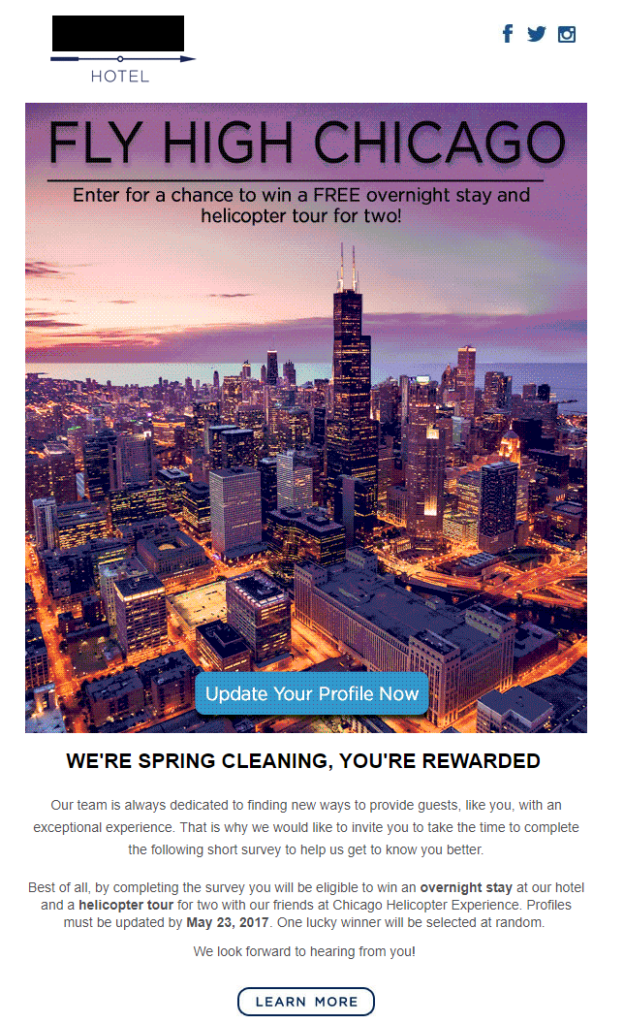Email, and email marketing, is not dead. Please stop writing think pieces planning its premature funeral.
In fact, email marketing has still got serious spunk. It continues to report high ROI on a consistent basis. A June 2016 survey from the Direct Marketing Association (DMA) and Demand Metric reported that email had a median ROI of 122%. That is four times higher than other marketing formats examined in the study, including social media, direct mail, and paid search.
But that does not mean email marketing has not changed in the past 20+ years. Between mobile design, personalized elements, and serious automation tools, emails look nothing like the plain text paragraphs we used to know. And all of these new technologies in email marketing ultimately attribute their successes to the same thing: a strong email list.
While email lists in the hundred thousands often sound impressive, the raw number of subscribers on an email list is not that important. Rather, the key to a good email list is to prioritize quality of subscribers over quantity.
Check out these basic actions to keep your hotel’s email list happy, healthy, and full of quality subscribers.
Regularly scrub your list.
We are talking about a deep clean of your list. While most email marketing clients automatically remove those whose emails are no longer valid (bounces) or who have purposefully unsubscribed, you need to dust, vacuum, and wash your list beyond that. Subscribers who are not engaged are not worth your send.
Identify the disengaged subscribers.
Before you go crazy cleaning your list, use the data you have to your advantage. If you use MailChimp, they have a 16-point scale that measures subscriber engagement to help you narrow down those who are no longer engaged. If you do not use MailChimp, look into how your email marketing client can measure engagement. Metrics like open rates, click rates, and add date all contribute to how engaged a subscriber is. If someone has not opened your email in the last year, they are unlikely to randomly become engaged again.
Try a re-engagement campaign.
Now that you have identified those disengaged subscribers, pause before hitting that delete button. Consider a re-engagement campaign first. A re-engagement campaign specifically targets those with low engagement, is sent exclusively to those subscribers (not your whole list), and should offer an incentive to become engaged again. For example, a hotel re-engagement campaign could offer a special 15% off deal or a free suite upgrade. Check out this ecommerce example for some inspiration. This is a good example because it is carries the “we miss you!” message throughout the subject, header, and copy. Plus it uses humor to lighten the tone of the email. But the most important part is it gives a clear incentive for people to re-engage: ~$13 off the subscriber’s next purchase. Want to see what a hospitality re-engagement campaign could do? Get in touch and we can talk strategy.
But still scrub your list.
You may have won some people back with your campaign. Congrats on successful re-engagement! But that does not mean you can forego cleaning. Still remove those who did not engage with your final effort. Ultimately, email lists should not be about the quantity of subscribers you have, but about the quality of subscribers.
Segment your list to the best of your ability.
Email list segmentation is basically about placing your subscribers into groups. You can then send these specified groups individual emails that are tailored to them. It allows you to send targeted messages to those it is most relevant to, rather than sending the same mass email to everyone and seeing what sticks.
Plus, segmentation is one of the most powerful things you can do with your email list. According to the Direct Marketing Association (DMA)’s National Client Email Report, segmented and targeted emails generate 58% of all email-driven revenue.
Segments for hotels will vary depending on what kind of hotel you manage. If you have award-winning spas or restaurants on site, you should segment out those interested in your dining or spa services through checkboxes at sign-up so you can send them relevant deals and updates . If your hotel does not have any large-scale amenities, you can still segment groups by traveler type such as business travelers versus leisure travelers or individual travelers versus family travelers. To create traveler type or interest type segments, you will need to collect additional segmentation-related data.
Prioritize collecting segmentation-related data.
The most basic segmentation data you can incorporate into your list is source data. What source did you get these emails from? If they signed up on your website, your email marketing client will usually incorporate that data automatically. However, if you manually input emails, make sure to include how those were obtained.
For example, say you hosted a wedding expo at your hotel. At the event you had an email sign-up. When you manually add these emails to your list, you include the name of the event and the date it was held. Then, a few months later when you run a bridal room blocks promotion, you can send a specialized message to a segment that includes those who signed up at the event. You know these people are interested in weddings and learning more about your hotel. It is a targeted message sent to a relevant group.
Explore ways to collect additional subscriber data after sign-up.
Beyond source data, you can analyze user behavior to further segment your list (but that is a whole other blog post). With your engaged subscribers, you can also try reaching out for more information or use surveys to gain information. While these types of emails are complicated (again, more blog post potential), the key to getting anyone to provide additional information or take your survey is to offer an incentive.
Take for example the following email from a Blue Magnet Interactive client who is a boutique Chicago hotel. This email asks subscribers to take a survey that asked questions to expand upon their “profile”. Questions included if they traveled on business or leisure, what months of the year they often travelled, and how they liked to book their stay at the hotel. By obtaining this data, the hotel could then segment their subscriber list based on the answers.

The survey link was clicked over 2200 times. It is important to note that the hotel included a strong incentive to take the survey with the free night stay AND a helicopter tour of the city. Now, they have more information on 2200+ people to better serve and market to their customers.
This example reinforces the fact the more data you have to segment your list, the more potential you have to send highly relevant emails to a targeted group. If the incentive is strong enough, people are happy to tell you more about themselves.
Actively pursue new subscribers.
Your email list is useless if it is outdated. It should be an ever-evolving, practically living thing. And that means adding new subscribers as often as you can. That is not saying you have to make it a main objective for your digital marketing strategy, but with a few basic tactics, you can get your sign-up in front of more eyes.
- Include a checkbox opt-in when users complete a form. But please, for the love of god, do not make it something they have to uncheck. Then people just feel tricked.
- Include a sign-up CTA on your check-rate thank you page.
- Play with a sign-up CTA (in the form of a button or pop-up) consistently across your site. Try out different locations like your footer or sidebar. You could even A/B test to see what works best.
- Put a sign-up CTA at the end of every blog post (because you should have a hotel blog). People are clearly interested in your content. Make sure they never miss it.
- Integrate it with your social media. Did you know there is a Facebook Page integration for MailChimp?
- Offer a discount when a guest signs up for your email list. This can be something as simple as 10% off a stay, but it is a tried and true method for a reason.
Ultimately, just make your email sign-up easy to find. Speaking personally, there have been a few different brands I have been really invested in and actively wanted to be on the email list for. Yet, I had a difficult time finding their sign-up on their website. In one case, I even had to resort to tweeting them. So please, make it as obvious and easy as possible.
Remember to always include an unsubscribe option.
While you do not want to encourage people to unsubscribe, you are legally required to include an unsubscribe option in every email you send. Beyond avoiding legal liability, you should make sure unsubscribing is an easy, one-click process. If it is not, you are going to piss customers off and risk being reported for bad email practices–which could eventually result in getting your email marketing account banned. If you really love your subscribers, let them go.
Have some (educated) fun with your subscribers.
While maintaining a consistent brand is important, that does not bar you from experimenting with your email marketing. With all the advancements in email marketing creation, you can try new things to keep your audience engaged and excited.
Before you go crazy with the hip new trends, make sure you know your audience. Do they view on mobile? Desktop? Which devices are they using? Which browsers do they use? Or do they prefer a particular email client? The answers to all these questions will inform what you can and cannot do, as there are some email marketing advancements that simply are not yet supported by all formats (lookin’ at you, Outlook). While some email marketing clients like MailChimp build-in fallback options, if a significant chunk of your audience cannot utilize or even see the cool new thing in your email, you may have to reconsider.
Furthermore, it is really helpful to A/B test in order to get a sense of what your subscribers engage with. You can test different subject lines, different send times, and even different in-email content. If you want to experiment with in-email content, try playing with emojis, countdowns, or—a Blue Magnet favorite—gifs. And if you are nervous about performing email experiments by yourself, we can help.
Quality > Quantity
You strive to make sure your guests have the best experience at your hotel, utilizing open communication while you do so. Why should it be any different with your marketing?
Email is one of the last remaining direct links you have to your guests. No algorithms, no ad spends, just content straight to them (or at least their inbox). So do not waste sends on people who will never open your emails: focus on the quality of your subscribers, not the quantity.
Keep your email list happy and healthy by regularly scrubbing disengaged subscribers, segment your list to deliver relevant content to target groups, actively add new subscribers, and experiment with your emails to better understand what your subscribers like. Soon you will have an email list of such quality, it is worth bragging about.
Want help making your email list better? Drop us a line.




